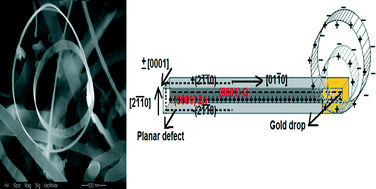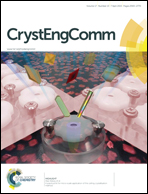Effects of Sn atoms on formation of ZnO nanorings
Abstract
Sn-doped ZnO nanobelts (NBs) and nanorings were grown on Si(100) substrates with the assistance of a gold catalyst, using a thermal evaporation method. The source material was placed at 1100 °C, while the substrates were placed at 700 and 800 °C. ZnO NBs with different sizes were obtained at different substrate temperatures. In addition, undoped ZnO NBs were grown under the same conditions. Field emission scanning electron microscope (FESEM) images showed that some nanorings were formed at the ends of the Sn-doped ZnO NBs, whereas no nanorings were observed for the undoped ZnO NBs. Furthermore, these images showed that some NBs were grown via a vapor–liquid–solid (VLS) mechanism. High-magnification transmission electron microscope (HRTEM) images and the selected area electron diffraction (SAED) pattern showed that the Sn-doped ZnO NBs were grown along the [01![[1 with combining macron]](https://www.rsc.org/images/entities/char_0031_0304.gif) 0] direction. In addition, a HRTEM image of a single Sn-doped ZnO NB revealed that the nanorings were formed as a result of planar defects. The X-ray diffraction (XRD) patterns indicated a wurtzite phase for the undoped and doped ZnO NBs. Room temperature photoluminescence (PL) spectroscopy and UV–vis diffuse reflectance spectra (DRS) measurements were used to study the optical properties of the nanostructures. PL and DRS results showed that the band gap of Sn-doped ZnO NBs was widened in comparison with the band gap of undoped ZnO NBs. Finally, the samples were characterized by X-ray photoelectron spectroscopy (XPS) and a relationship between the XPS results and O vacancy of the ZnO NBs was observed.
0] direction. In addition, a HRTEM image of a single Sn-doped ZnO NB revealed that the nanorings were formed as a result of planar defects. The X-ray diffraction (XRD) patterns indicated a wurtzite phase for the undoped and doped ZnO NBs. Room temperature photoluminescence (PL) spectroscopy and UV–vis diffuse reflectance spectra (DRS) measurements were used to study the optical properties of the nanostructures. PL and DRS results showed that the band gap of Sn-doped ZnO NBs was widened in comparison with the band gap of undoped ZnO NBs. Finally, the samples were characterized by X-ray photoelectron spectroscopy (XPS) and a relationship between the XPS results and O vacancy of the ZnO NBs was observed.


 Please wait while we load your content...
Please wait while we load your content...